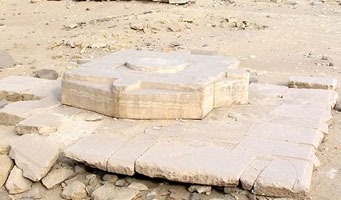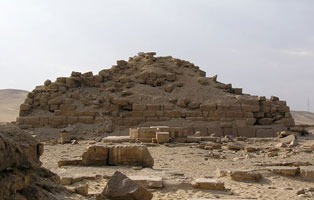Introduction: Abusir’s Sun Temples—A Sacred Site Between Giza and Saqqara
Hidden between the world-famous and the vast necropolis of Saqqara lies , Egypt, a lesser-known but incredibly significant archaeological site that offers deep insights into and ancient spiritual life. Located about 25 kilometers south of Cairo, on the western bank of the Nile, Abusir formed part of the expansive and served as a royal burial ground and religious hub during Egypt. The name “Abusir” is derived from the ancient Egyptian phrase Per-Usir (House of Osiris), suggesting it had religious significance even before becoming a center of .
The Sun Temples of Abusir
A Shift in Religious Paradigms
What makes Abu Sir, Egypt especially remarkable are the monumental structures built during the 5th Dynasty, dedicated to the . These marked a pivotal transformation in religious ideology, where the pharaoh was not only seen as a king but also as the earthly representative and “Son of Ra.”
Niuserre’s Sun Temple: Shesepu-ib-Ra
Among these, the most significant and best-preserved is the , known as Shesepu-ib-Ra. This majestic structure featured a large open courtyard for rituals, a stone altar for offerings, and a towering obelisk-like symbol representing the rays of the sun. Its walls were adorned with vibrant reliefs illustrating solar ceremonies, royal processions, and festivals honoring Ra.

Function and Legacy of the Sun Temples
Living Temples for a Living God
Unlike traditional mortuary temples, the functioned as a living religious institution. Daily rituals and offerings were performed at sunrise and sunset, celebrating the sun’s journey across the sky and reinforcing the cosmic order known as Ma’at.
Influence on Later Theology
These practices tied the concepts of kingship, fertility, and divine legitimacy directly to the cycle of the sun. This growing emphasis on during the 5th Dynasty laid the groundwork for future theological developments, particularly the revolutionary ideas of the Amarna Period.
Archaeological Insights and Enduring Significance
Carvings and Rituals
Though time, erosion, and neglect have affected the condition of the site, many of the architectural and artistic features of the Niuserre Sun Temple still remain intact. Archaeologists have discovered detailed carvings depicting boat festivals, animal sacrifices, and symbolic rituals that offer a vivid glimpse into the ceremonial life of the era.
A Unique Experience for Modern Visitors
Today, visiting Abusir provides a tranquil and immersive experience far from the crowded tourist trails of Giza. Its combination of , pyramids, and tombs makes it a unique destination for anyone seeking to explore the spiritual legacy and architectural innovation of .
Userkaf’s Temple of the Sun: Nekhen-Re
Rediscovering a Lost Monument
Nestled on the desert plateau between Giza and Saqqara, the necropolis of Abusir stands as a testament to the Old Kingdom pharaohs who sought eternal rest and divine favor within its sands. While overshadowed by the colossal pyramids of Giza and the stepped pyramid of Saqqara, Abusir holds its own unique treasures, none perhaps more intriguing and historically significant than the solar temples, particularly the grand “Temple of the Sun” of Userkaf.
Architecture and Symbolism
A Revolutionary Design
The very concept of a “Sun Temple” in ancient Egypt is a departure from the traditional pyramid complex. Six such temples are believed to have been built, though only two have been definitively located and partially excavated: that of Userkaf and Nyuserre Ini.
Features of Nekhen-Re
Userkaf’s Temple of the Sun, known in ancient Egyptian as (“The Stronghold of Re”), was not a place for burial but a vibrant center of cultic activity. Its design was a radical departure from the pyramid complexes that preceded it.
The Obelisk: Monument of Light
At the western end of this vast courtyard rose the temple’s most defining feature: a colossal, squat obelisk, built on a mastaba-like base. While the original height is debated, it could have reached around 36 meters (118 feet) or more.

Ritual Practices and Functions
A Temple for the Living SunRitual Practices and Functions
A Temple for the Living Sun
The temple complex itself was meticulously planned and oriented. A causeway, similar to those leading to pyramid temples, connected the Sun Temple to the Nile valley. Within the temple, various structures supported the daily rituals, including a large altar and a “slaughterhouse” for animal sacrifices.
Ceremonial and Political Roles
Primarily, it served as a terrestrial dwelling for Ra, a place where the king could ritually interact with the divine power of the sun. The temple also likely played a role in the pharaoh’s journey to the afterlife, associating him with the eternal cycle of the sun.
Decline and Rediscovery
Abandonment and Erosion
Despite its innovative design and profound religious significance, the Sun Temple of Userkaf, like others of its kind, fell into disuse and was eventually dismantled.
Excavation and Modern Understanding
The excavation of Userkaf’s Sun Temple by Ludwig Borchardt in the early 20th century, and later by Czech archaeologists, has been crucial in piecing together its form and function.
Final Reflections
A Forgotten Jewel Reconsidered
Today, the Temple of the Sun of Userkaf remains a “forgotten jewel” not only because of its state of preservation but also because it is often overlooked in favor of the more visually spectacular pyramids.
Legacy of Light and Power
For those willing to venture beyond the well-trodden paths, the ruins of Userkaf’s Sun Temple in Abu Sir offer a powerful, if somewhat ghostly, reminder of a time when the pharaohs looked directly to the sun for their power and their eternal destiny.
